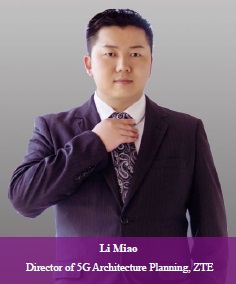Meeting the Business Challenges of Future with Flexible 5G RAN Architecture

Compared with the evolution of previous radio technologies, 5G is a comprehensive technological innovation. 5G has three critical application scenarios: eMBB, uRLLC, and mMTC, which are designed for IoT business with heavy traffic, low latency and high reliability, and low power consumption respectively. 5G covers various fields like UHD video, AR/VR, smart grid, smart transportation, industrial automation, and automated driving.
It can be seen that when compared with 4G that focuses on mobile broadband services only, 5G has a broader vision and its target markets also evolve from the pure CT market to various vertical industry markets. However, under the new situations, the traditional NE-based access network architecture with software functions closely coupled to hardware goes no further. New access network architecture that is more flexible, universal, and self-adaptive is needed to adapt to massive market features and service requirements. New RAN split architecture is therefore used in the 5G network.On the one hand, it is necessary to introduce centralized units in the 5G era, while on the other hand, distributed units must also be retained. To achieve the two objectives, ZTE uses a separable, flexible RAN architecture to provide more agility in a variety of scenarios.
RAN Split
ZTE's 5G architecture provides functional split at the higher layer of radio protocol stack in compliance with 3GPP standards. This means that the BBU function in 5G is reconfigured and divided into two functional entities: centralized unit (CU) and distributed unit (DU). The two functional entities process different data based on whether the processing procedure meets the real-time requirements. CU provides the functions of non-real-time high-layer radio protocol stack, and also supports localization and deployment in the network edge of some CN functions and applications. DU provides the physical layer function and real-time layer-2 function.
Cloud and Non-Cloud Based Deployment
After the two functional entities (CU/DU) are split, the CU bearing non-real-time functions can be deployed on general-purpose hardware, with high-layer functions of the access network operating on virtual machines, while the DU still uses dedicated hardware. This architecture, where CU is deployed in a centralized manner, is called cloud CU. Comparatively speaking, there are two types of non-cloud deployment architecture of the traditional access network without introducing virtualization technologies. One is D-RAN, where multiple BBUs are completely independent and are not co-located. The other is C-RAN, where multiple BBUs are co-located, so that the baseband resources of the BBUs may be shared or isolated from one another.
ZTE's 5G RAN supports all above-mentioned deployment architectures. This is not only for forward and backward compatibility, but also more primarily for adapting to complicated and diverse service scenarios.
CP/UP Convergence Optimization
ZTE's 5G RAN can also optimize using the converged control planes (CPs) and user planes (UPs) on the CU unit. For CPs, the convergence of CPs corresponding to multiple cells or sites allows unified resource coordination, interference control, and load balancing. Both the efficiency and the effect are better than those of the distributed interface-based inter-sites/cells RRM procedure. For UPs, the convergence of multiple UPs is beneficial to cross-cell or even cross-site packet processing. For packets that previously needed to be delivered through an interface, only context reusing on the centralized unit is required now, and the bearer between RAN and CN that previously needed to be migrated in the mobility procedure can now be reused.
Further CP/UP Split
Based on the CU/DU split, to adapt to different service requests, CP and UP can be further split at the CU side of the access network. After the split, CP and UP are decoupled from each other. They interact through the standard E1 interface and can be deployed on different physical nodes.

As described above, after the introduction of the CU/DU split, multiple architectures appear in the 5G RAN, including D-RAN, C-RAN, and cloud-RAN, and the further CP/UP split makes architecture change diversely. However, the architectures are not mutually exclusive. Operators and users can flexibly deploy their networks based on their own needs.

Fig. 2 lists some rules for using the three deployment architectures. The evolution from traditional 4G networks to 5G networks can start from the D-RAN deployment architecture and then gradually introduce more architectures. After the mature commercial deployment of 5G, the three architectures can still co-exist in the same network based on areas and service needs. ZTE's 5G RAN has flexible topology architectures that can be compatible with ideal fronthaul and non-ideal fronthaul transport environments. It not only supports various deployment architectures, but also can use its self-adaption feature to adjust the architecture based on different application scenarios.
Two typical 5G application scenarios are listed below, which describe how the flexible 5G RAN architecture adapts to the scenarios to deliver best user experience:
● Convergence of 4G and 5G networks: In this scenario, LTE and 5G dual-connectivity mode is used. CP signaling passes LTE base stations to ensure continuous coverage. UP data passes 5G DU for heavy-traffic wireless access. High-layer CP and UP protocols all converge at the CU. When a terminal moves, the CP and UP anchors do not change. This ensures seamless mobility.
● Internet of vehicles (IoV): DUs are deployed by roadsides to assist in distribution of vehicle-side V2V/V2X radio resources. CUs can be deployed on upper-level nodes. The application server can be deployed at the CU side to provide fast feedback interaction over the application layer.
In summary, functional split at the RAN side makes it possible to reconstruct the service-driven access network. Such reconstruction includes not only function layer split, but also processing convergence, applications localization, and CN functions integration. More importantly, the network can automatically enable its required architecture. ZTE’s 5G RAN architecture is versatile and flexible enough to meet the commercial needs of 5G IoT and the future development trend of mobile communications.
[Keywords] Flexible 5G RAN architecture, RAN split, CP/UP convergence optimization, CU/DU